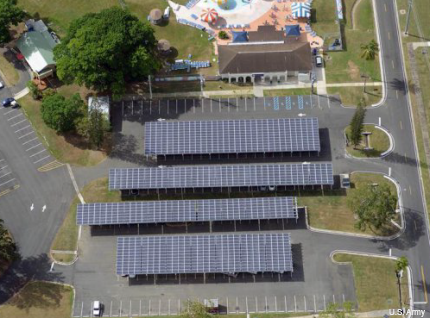How one Army base is getting to 'net zero' energy use
Fort Buchanan uses an incentive-laden Army Corps of Engineers program to install solar, wind and water systems while cutting usage rates.

Solar panels at Fort Buchanan also serve as parking canopies, effectively providing light and shade at the same time.
In an example of its push toward “net zero” energy environments, the Army is using a savings-based contracting program to install solar and wind power systems at a base in Puerto Rico while cutting usage rates and augmenting its water supply.
The Army is adding two wind turbines at Fort Buchanan to supplement the power from 21,824 solar panels. The turbines could produce about 5 percent of the base’s current electric needs. The 5.5 megawatts produced by the photovoltaic panels could cover 60 percent.
The initiatives are being performed under the Army Corps of Engineers' Energy Savings Performance Contracting, or ESPC, program, a public/private effort that supplies money and expertise for projects to improve energy and water-use efficiencies. And, like energy and water efforts at other bases, they are part of the Army’s net zero goal of producing as much energy as it uses at its installations, the Army said in a release.
The U.S. military, which is the largest single user of energy in the world, with an annual tab of at least $20 billion, is becoming something of a leader in the green energy field. Earlier this year, the Army broke ground on what would be its largest solar array so far, at Fort Huachuca, Ariz. The other military services similarly has been pursuing solar and wind sources of energy. In all, the Defense Department has set a goal of using renewable resources for at least 25 percent of its energy by 2025.
At Fort Buchanan, the solar and wind systems are being coupled with the installation of more efficient air conditioning and lighting systems to reduce power consumption, work that also was done through ESPC, which is managed by the Army Engineering and Support Center. ESPC partners with contractors to provide new systems but demands that they generate savings greater than what the program pays out. There are no up-front costs for the Army, and if the savings aren’t there, the contractor doesn’t get paid.
Fort Buchanan also installed a water well to reduce its reliance on Puerto Rico’s public utility for potable water, and created a 2 million-gallon lake, drawn from non-potable water well the government already had in place, for irrigation.
"In combination, all measures are expected to save about 30 percent of the fort's energy demand, and 60 percent of potable water demand, well in excess of current federal requirements," Yamil Hernandez of the base’s Directorate of Public Works Environmental Division, said in the release.
Saving on energy cost makes sense anywhere, but especially in Puerto Rico, where electricity rates are about twice as high as those in the continental United States, Hernandez said. And those higher rates also make solar and wind power even more feasible—the payback for a solar array in the continental United States is about 37 years; in Puerto Rico, it’s about 20 years.
NEXT STORY: Appel named to lead JIE implementation




